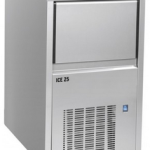

How does a commercial ice maker work?
Ice may not seem that important - until you don't have any, then it becomes a necessity! Imagine a party or a bar without ice. Many restaurants will have a commercial ice maker on the premises, because running out of ice is just not an option. From cocktails to keeping seafood fresh, a ready supply of ice is critical. Fortunately, there are many different types of ice makers for sale, to ensure that everything is kept cool.
Ice timing
When thinking about ice makers for sale, it is important to bear in mind that the rate and amount of ice that they can produce will vary. Choosing the right equipment for the job will depend to some degree on how much ice is needed during a specific time.
The essential elements for a commercial ice maker include plenty of water, a way of freezing it, and some method of collecting the ice. One of the most elementary systems for making ice on a large scale features an ice tray that is held vertically, in which the water freezes into cubes or other shapes before being released and collected.
Cycle of ice
A commercial ice maker features a system of coiled pipes that exchange heat, much like the ones that can be found at the back of the refrigerator in your kitchen. The system includes a compressor that drives the refrigerant around the circuit of pipes and various other parts, to freeze the water and produce ice. The refrigerant is generally a fluid that may change into a gas and then back into a fluid again during different parts of the cycle, which is continuous.
The compressor pushes the refrigerant through the condenser, which is a small tube which condenses the refrigerant, and then on into a larger tube known as the evaporator, where the refrigerant expands.
Condensing the refrigerant increases its pressure, along with its temperature. While passing through the narrow gauge condensing pipes, warmth is lost to the colder air on the outside, and as a result, the refrigerant is condensed and becomes a liquid. When this compressed refrigerant liquid moves into the expansion segment of the system, it starts to evaporate. As it does so, it expands and turns into a gas. Evaporation is critical to making ice, as this part of the cycle sucks up heat from the surrounding pipes, which are attached to the ice tray, and the cold metal next to water forms ice.
A pump drives water into the system and over the ice trays where it eventually freezes. As the water is becoming frozen in layers, the resulting ice will be clear. At a set point, a valve attached to the heat exchange pipes switches the refrigerant to a different path and hot gas bypasses condensation and goes straight to the evaporator, where it heats the ice trays and allows the ice to slip out or be knocked out and then collected. These types of ice makers for sale produce ice of a regular size and shape and at regular intervals throughout a pre-determined period of time.
It is always advisable to purchase your ice machine from a supplier that has experience and can therefore help with your exact requirements supplying exactly what you need.


Validate your login
Login
Create New Account